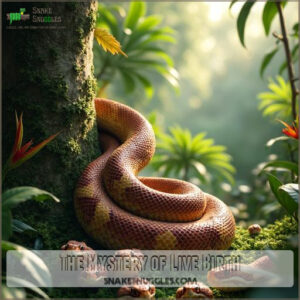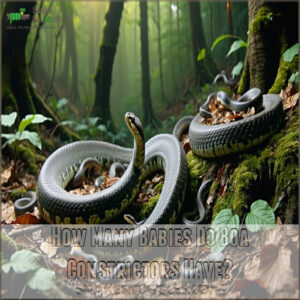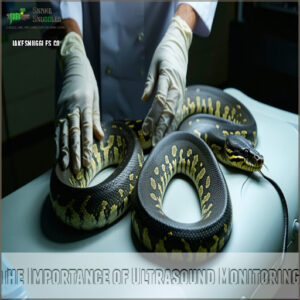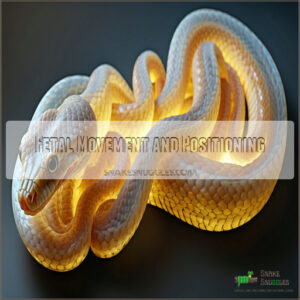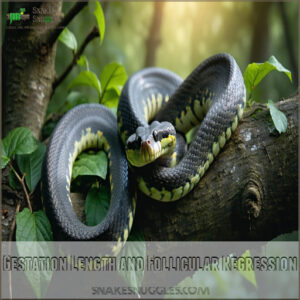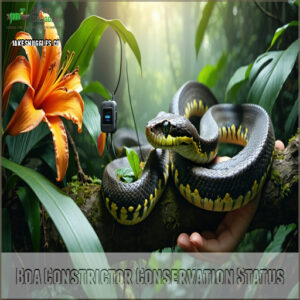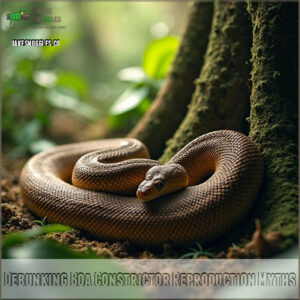This site is supported by our readers. We may earn a commission, at no cost to you, if you purchase through links.
 You might be surprised to learn that boa constrictors don’t lay eggs at all. These fascinating reptiles are ovoviviparous, which means they keep their eggs inside their bodies until they hatch.
You might be surprised to learn that boa constrictors don’t lay eggs at all. These fascinating reptiles are ovoviviparous, which means they keep their eggs inside their bodies until they hatch.
Think of it as nature’s version of a perfect incubator – mom provides protection and maintains ideal temperatures throughout the 4-8 month development period. While the embryos grow, they get their nutrients from a built-in lunch box called a yolk sac.
When it’s time, female boas give birth to 10-65 fully formed baby snakes, ready to tackle the world. The way these remarkable creatures reproduce reveals even more impressive survival adaptations in the animal kingdom, showing nature’s perfection.
Table Of Contents
- Key Takeaways
- Boa Constrictor Reproduction 101
- The Mystery of Live Birth
- Boa Constrictor Mating and Breeding
- Boa Constrictor Anatomy and Egg-Laying
- How Many Babies Do Boa Constrictors Have?
- The Importance of Ultrasound Monitoring
- Embryonic Development and Viability
- Boa Constrictor Parenting 101
- Boa Constrictor Conservation Status
- Debunking Boa Constrictor Reproduction Myths
- Frequently Asked Questions (FAQs)
- Do Boas lay eggs?
- How many babies does a boa constrictor have?
- How many eggs does a boa constrictor lay?
- Can a boa constrictor delay pregnancy?
- How do boa constrictors give birth?
- How do Baby boa constrictors hatch?
- Do boa constrictors have live birth or lay eggs?
- Why do boa constrictors not lay eggs?
- How long is a boa pregnant?
- How many babies can a boa constrictor have?
- Conclusion
Key Takeaways
- You won’t find boa constrictor eggs in the wild because they’re ovoviviparous – they keep their eggs inside their bodies until they hatch, rather than laying them like most other snakes.
- You’ll see boa constrictors give birth to 10-65 live babies after a 100-150 day gestation period, during which the embryos develop inside protective membranes and get nutrients from yolk sacs.
- You can track a boa’s pregnancy through ultrasound monitoring, which helps identify healthy embryo development and potential complications like follicular regression.
- You’ll notice that mother boas don’t stick around after birth – despite investing significant energy during pregnancy, they quickly return to their solitary lifestyle once their fully-formed offspring are born.
Boa Constrictor Reproduction 101
You’ll be surprised to learn that boa constrictors don’t actually lay eggs like most snakes you’re familiar with – instead, they’re ovoviviparous, which means they keep their eggs inside their bodies until they hatch.
Through this fascinating reproductive process, you’ll discover how mother boas protect and nourish their developing young for 4-8 months before giving birth to fully formed baby snakes.
This unique process allows mother boas to give their offspring the best possible start in life, and it’s a key aspect of what makes these snakes so fascinating.
What is Ovoviviparity?
Ever wondered why you won’t find boa constrictor eggs in the wild? Unlike most snakes that lay eggs, boas use a remarkable reproductive process called ovoviviparity.
During this specialized form of fetal development, embryos grow inside protective membranes within the mother’s body, nourished by yolk sacs. It’s nature’s way of keeping baby boas safe until they’re ready for their grand entrance as fully-formed snakes.
Understanding proper breeding techniques, such as those found at breeding techniques, is essential for successful boa constrictor reproduction.
How Does It Differ From Oviparity?
Think of ovoviviparity as nature’s VIP treatment for boa constrictors. Unlike oviparity, where eggs face the world alone, boa constrictor reproduction happens inside mom’s body.
It’s like having a built-in incubator!
- Eggs develop internally, protected from predators and harsh weather
- A yolk sac feeds the growing embryos, like a natural food delivery service
- Temperature regulation stays consistent, thanks to mom’s body
- Development time is flexible, adapting to ideal conditions
Advantages of Ovoviviparity in Boas
While other snakes lay eggs, boa constrictors take a different approach with ovoviviparity – it’s like having a built-in incubator! This reproductive strategy gives them amazing advantages in the wild.
| Benefit | How It Works | Why It Matters |
|---|---|---|
| Embryo Protection | Mother’s body shields developing babies | Guards against predators and weather |
| Temperature Control | Internal environment stays perfect | Guarantees ideal development |
| Resource Sharing | Direct nutrient transfer from mom | Stronger, healthier offspring |
| Survival Success | Babies born fully developed | Ready to tackle life immediately |
This efficient system helps more baby boas survive, making ovoviviparity a winning strategy in nature’s game, with amazing advantages, ideal development, and stronger, healthier offspring.
The Mystery of Live Birth
You’ll be amazed to learn that boa constrictors don’t lay eggs like most snakes you’re familiar with – instead, they’re ovoviviparous, which means they keep their eggs inside their bodies until they hatch.
As the embryos develop within specialized membranes inside the mother snake, they’re nourished by yolk sacs until they’re ready to emerge as fully-formed baby boas.
Why Don’t Boa Constrictors Lay Eggs?
Unlike most snakes that lay eggs, boa constrictors have evolved a fascinating reproductive strategy called ovoviviparity.
Through this process, instead of laying eggs externally, the mother retains and develops them inside her body. During fetal development, embryos grow safely within specialized membranes, nourished by yolk sacs.
This unique reproductive adaptation means you’ll never find boa constrictor eggs in the wild – they’re internal incubators! Boa constrictors exhibit a remarkable reproductive method that guarantees the survival of their young.
Evolutionary Benefits of Live Birth
You’re about to discover why live birth gives boa constrictors their evolutionary edge. This remarkable reproductive strategy (called ovoviviparity) isn’t just fascinating – it’s a game-changer for survival.
- Internal development shields babies from predators and harsh weather
- Mother’s body regulates perfect temperature for growth
- Continuous nutrient supply through specialized membranes
- Better survival rates compared to egg-laying species
- Flexible birth timing based on environmental conditions
These adaptive traits have made boa constrictors incredibly successful in diverse habitats with an evolutionary strategy that provides a game-changer for survival and results in better survival rates.
How Do Boas Support Fetal Development?
Inside a mother boa’s body, fetal development happens like a well-orchestrated symphony. The embryonic development process relies on several fascinating systems working together.
Here’s how these remarkable snakes support their growing offspring:
- The yolk sac acts as a natural feeding tube, delivering essential nutrients straight to the embryo
- Temperature-controlled internal environment guarantees favorable growth conditions
- Specialized membranes enable efficient oxygen exchange between mother and babies
- Maternal health directly influences reproductive health through shared blood circulation
This unique reproductive strategy is characterized by ovoviviparous development, which gives developing neonates the best start possible. Rather than external egg incubation, this ovoviparity strategy gives developing neonates the best start possible, highlighting the importance of maternal health and reproductive health in the development process.
Boa Constrictor Mating and Breeding
You’ll find that boa constrictors are surprisingly romantic during their mating season, which typically occurs from April to August when males follow females’ pheromone trails and engage in elaborate courtship displays.
After successful mating, you’ll need to wait 100 to 150 days for the gestation period to complete, during which the female’s body provides everything needed for the developing embryos, in a process that is both complex and highly elaborate.
Mating Season and Behavior
Every spring, boa constrictors kick off their mating rituals with an impressive display of natural behavior. Males actively search for females between April and August, following scent trails and performing intricate courtship displays.
When a female’s ready to mate, she’ll release special pheromones that attract potential partners.
The male then uses special organs called hemipenes during the mating process to guarantee successful fertilization.
Fertilization and Embryonic Development
The fascinating journey of boa constrictor fertilization begins when sperm transfer triggers egg formation inside the mother’s body. Through ovoviviparity, these remarkable snakes support embryo growth differently than egg-laying species.
You’ll find the reproductive cycle involves careful embryonic development, where each fertilized egg develops internally rather than in a nest. The reproductive strategy provides a safe environment for fetal development, with the mother’s body maintaining ideal conditions.
Boa constrictors exhibit unique reproductive traits that set them apart from other snake species, showcasing their unique reproductive cycle and reproductive strategy.
Gestation Period and Birth
You might think boa constrictors lay eggs, but here’s what really happens during their pregnancy. The gestation period runs about 100-150 days, where fetal development occurs inside mom through ovoviviparity – a unique form of reptile reproduction.
During this time, you’ll notice:
- The female’s body temperature rises slightly to support embryo growth
- Her appetite decreases as birth approaches
- Visible movement of babies can be seen through her scales
- The birth process takes several hours, with neonates emerging one by one
Each pregnancy produces anywhere from 10-64 live young, making the birth process quite the show for snake enthusiasts.
Boa Constrictor Anatomy and Egg-Laying
You’ll be surprised to learn that unlike their snake cousins who lay eggs, boa constrictors use a fascinating reproductive method called ovoviviparity where eggs develop inside the mother’s body.
In this special process, you can watch as the mother boa’s specialized oviducts nurture the developing embryos until they’re ready to emerge as fully formed baby snakes, no egg-laying required, which is a unique aspect of their reproductive method and allows them to give birth to live young through a process that is both complex and highly efficient, showcasing the remarkable biology of boa constrictors.
The Role of Oviducts in Ovoviviparity
You’ll be amazed by how boa constrictors’ oviducts work – they’re like high-tech incubators! While other snakes lay eggs, boas keep their eggs inside specialized oviducts that act as nature’s perfect nursery.
Here’s how these remarkable structures support life: Understanding proper snake care techniques is essential for their well-being.
| Oviduct Feature | Function for Baby Boas |
|---|---|
| Protective Lining | Cushions developing embryos |
| Blood Vessels | Delivers oxygen and nutrients |
| Muscle Layers | Controls temperature regulation |
| Secretory Cells | Produces nourishing fluids |
For more information, visit snake care techniques to learn about the best practices for their well-being and how oviducts play a crucial role in their development.
How Do Boas Support Embryonic Growth?
You’ll be intrigued by how boa constrictors support embryonic development through ovoviviparity.
Unlike egg-laying snakes, boas have evolved a remarkable internal system for fetal development.
- The yolk sac acts like a natural feeding tube, delivering nutrients directly to growing embryos
- Maternal nutrition influences embryo health through specialized blood vessels
- Internal development maintains perfect temperature for growing neonates
- The mother’s body provides a protective environment, shielding embryos from external threats
The unique aspects of ovoviviparity in boas highlight a complex and highly specialized reproductive strategy.
The Absence of Egg-Laying in Boas
Three key differences set boa constrictors apart from egg-laying snakes.
Instead of laying eggs, they’ve evolved to use ovoviviparity – keeping their young inside until they’re ready for the world.
| Feature | Comparison | Benefit |
|---|---|---|
| Development | Internal | Protected growth |
| Nutrition | Yolk sac | Consistent feeding |
| Birth type | Live birth | Higher survival |
This snake reproduction method gives baby boas a head start in life, much like mammals do, utilizing a method that provides a head start.
How Many Babies Do Boa Constrictors Have?
You’ll be amazed to learn that boa constrictors can give birth to anywhere from 10 to 65 babies in a single litter, making them quite the productive parents in the snake world.
If you’re wondering about timing, these remarkable reptiles typically welcome their offspring after a 100 to 150-day gestation period, during which the baby boas develop completely inside their mother’s body.
Average Litter Size and Range
While exploring boa constrictor reproduction, you’ll be fascinated by their impressive birth rates. These remarkable snakes typically welcome between 20-30 offspring per litter, though some super-moms have been known to deliver up to 64 babies at once! That’s quite the snake family reunion.
Here’s what makes boa constrictor litter sizes so interesting:
- Each newborn measures about 2 feet long – imagine a living room full of these tiny serpents!
- Wild populations consistently show an average of 25 neonates per birth
- Reproductive health peaks during the dry season (April-August)
- Fetal development takes 5-8 months, resulting in fully formed babies
- Female boas can start having babies at just 2-3 years old
These impressive numbers aren’t just for show – they’re nature’s way of ensuring species survival. What’s even more remarkable? These newborn boa constrictors come into the world ready to rock, requiring zero parental guidance. Talk about independent kids!
Factors Affecting Litter Size
Ever wonder what shapes a boa’s family size? The litter size in boa constrictors depends on several key factors that’d surprise you.
Mature females in their prime reproductive age typically produce larger litters, while first-time moms have fewer babies.
Diet quality, body condition, and stress levels play pivotal roles too.
Even subtle changes in temperature and humidity can impact how many healthy neonates a boa will birth.
Newborn Boa Constrictor Development
Newborn boa constrictors come into the world ready for action! After spending 100-150 days developing inside mom, these foot-long neonates are fully equipped with hunting instincts and survival skills.
Your baby boa’s development is a marvel of nature – they’ll start hunting small prey right away, using their natural constricting abilities to secure meals.
Watch these tiny predators double in size within their first year, showcasing their remarkable growth and natural constricting abilities to secure small prey.
The Importance of Ultrasound Monitoring
You’ll find that ultrasound monitoring is essential for tracking your boa constrictor’s reproductive cycle, from the early stages of follicle development to the final phases of pregnancy.
While your snake won’t lay eggs like many other reptiles, this modern imaging technique lets you peek inside to monitor the health and development of those tiny snake babies growing right inside mom’s body.
Tracking Reproductive Cycles in Boas
You might wonder how breeders keep tabs on boa constrictors’ reproductive health. Ultrasound imaging has revolutionized snake reproduction monitoring, letting us peek into their mysterious world during breeding season (April to August).
Breeders can purchase boa constrictor ultrasound equipment.
Here’s how ultrasound helps track boa ovoviviparity:
- Maps follicle growth patterns to pinpoint prime mating windows
- Monitors embryo development in real-time, ensuring healthy gestation
- Calculates precise delivery dates for successful births
Think of it as a snake’s prenatal checkup – just without the waiting room magazines!
Follicle Development and Mating
Inside a female boa’s body, follicle development kicks off an intricate reproductive dance. Using ultrasound imaging, scientists track follicle growth patterns that signal mating readiness.
When follicles reach about 30mm, they’re primed for the fertilization process.
During mating rituals, males detect pheromones and engage in complex courtship behaviors, wrapping around females in synchronized movements that can last several hours.
Post-Ovulatory Phase and Slug Identification
Through ultrasound imaging, veterinarians can track your boa’s post-ovulatory phase and identify slugs – those unfertilized eggs that sometimes pop up during reproductive cycles. Unlike healthy embryonic development, slugs appear more echogenic and oval-shaped under examination.
Three key indicators of successful ovoviviparity:
- Clear fetal growth patterns
- Regular embryo development milestones
- Proper reproductive health markers
Let’s dive deeper into slug morphology and what it means for your snake’s reproductive journey.
Embryonic Development and Viability
You’ll be amazed to see how boa constrictor embryos develop inside their mother’s body, where they’re protected by special membranes and nourished by yolk sacs throughout their growth.
During the 100-150 day gestation period, you can track these tiny champions’ progress as they show early signs of movement and heart activity.
Getting ready for their grand entrance into the world is an exciting time, as they prepare to leave the protection of their mother’s body and start their new life.
Embryonic Vesicle and Cardiac Activity
Watching a boa constrictor embryo develop is like witnessing a tiny miracle through a window. During embryonic development, you’ll spot the first signs of life around month two, when the embryonic vesicle forms – think of it as the baby boa’s first home.
The real show starts when cardiac activity becomes visible, with the heart pumping away like a determined little drummer.
- Your heart will skip a beat seeing that first flutter of cardiac development
- You’ll be amazed how perfectly formed each tiny structure appears
- The rhythmic heart movements remind you of life’s persistence
- Each vesicle formation tells a story of survival
- The steady beat of heart activity signals hope for a healthy snake
Fetal Movement and Positioning
Fetal movement tells an incredible story in boa constrictors. During the final weeks of internal development, you’ll spot these tiny serpents shifting and repositioning through ultrasound monitoring.
Their embryo position changes frequently as they prepare for birth, much like a graceful underwater dance.
This fetal development process, unique to ovoviviparity, shows how the mother’s body creates the perfect environment for these future hunters.
Understanding snake egg laying patterns, including snake clutch sizes, can provide valuable insights into the reproductive habits of various species.
Gestation Length and Follicular Regression
The miracle of fetal development in boa constrictors follows a fascinating timeline. During the gestation period, which typically spans 101 days, you’ll see remarkable changes in the mother’s body.
While most pregnancies progress smoothly, about 13% of cases show follicular regression, where follicles larger than 30mm return to earlier stages.
Notably, this reproductive cycle doesn’t vary between first-time mothers and experienced ones, showing nature’s consistent approach to embryo formation.
Boa Constrictor Parenting 101
You’ll be surprised to learn that boa constrictors aren’t exactly winning any "Parent of the Year" awards, as these remarkable reptiles don’t stick around to care for their offspring after birth.
While mother boas invest significant energy during their 4-8 month pregnancy through ovoviviparity, providing a safe internal environment for their developing young, they’ll quickly part ways with their 10-65 newborns once they’re born.
Maternal Care and Nutrition
Unlike many reptile parents, boa constrictors don’t stick around for baby duty. After birth, mom’s got one priority: getting her strength back.
Her maternal nutrition needs skyrocket, requiring specific nutrients to bounce back from pregnancy. Think of it like an athlete after a marathon – she needs premium fuel to recover.
Proper reptile food choices are essential for her recovery, involving reptile dietary needs.
- Females need 2-3x their normal caloric intake post-birth
- High-protein meals help repair tissue and restore energy
- Calcium supplementation supports bone density recovery
- Hydration becomes critical for metabolic functions
- Frequent, smaller meals aid digestion during recovery
Post-Birth Care and Healing
After birthing her neonates, a female boa constrictor needs specialized postpartum care to heal properly.
Your focus should be on wound healing and restoring her energy reserves.
Keep her enclosure clean and quiet, maintain ideal temperature and humidity, and offer smaller meals more frequently.
Many keepers notice their boas bounce back faster when given extra TLC during maternal recovery.
The Solitary Nature of Boa Constrictors
While baby boas heal from birth, their moms quickly return to their solitary ways. You might think these powerful snakes would stick together, but boa constrictors are nature’s ultimate lone wolves.
In their natural snake habitat, they’ve mastered the art of solo living.
- They’re such independent creatures, they’ll actively avoid other boas outside mating season
- Their solitary behavior helps them become better hunters, as they don’t have to share territory or prey
- Each boa develops its own unique hunting patterns and favorite spots in the wild
- They’re perfectly content being alone, unlike many other reptiles that gather in groups
Their solitary nature isn’t just a preference – it’s key to their survival. They’ve evolved to thrive on their own, making them incredibly adaptable hunters.
Boa Constrictor Conservation Status
You’ll find boa constrictors facing serious conservation challenges in their native habitats across Central and South America, where they’re battling threats like deforestation and illegal pet trade.
If you’re wondering about their protection status, you’ll be glad to know that many countries have implemented strict regulations to safeguard these remarkable snakes.
Though there’s still work to be done to guarantee their long-term survival, many efforts are underway to address the challenges faced by these animals in the wild.
Threats to Wild Boa Populations
Wild boa constrictors face mounting challenges in their native habitats.
Let’s break down the major threats:
| Threat | Impact | Current Status |
|---|---|---|
| Deforestation | Loss of hunting grounds | Critical |
| Poaching | Population decline | Severe |
| Climate Change | Habitat disruption | Worsening |
| Pet Trade | Wild capture stress | Ongoing |
You’d be surprised – humans are behind each of these threats, from habitat loss to the exotic pet trade, these pressures are pushing wild populations to their limits, due to deforestation, poaching, and climate change.
Protected Status and Habitat Preservation
Legal protections for boa constrictors are making a real difference in their survival. Thanks to CITES Appendix II listing and habitat conservation efforts, these remarkable snakes have a fighting chance against extinction.
Here’s how wildlife protection measures are helping:
- Protected areas now span key boa territories, limiting habitat loss
- Local communities receive support for ecosystem preservation initiatives
- International trade regulations help combat poaching and illegal wildlife trafficking
Conservation efforts matter – these amazing creatures depend on our continued commitment to protecting their wild spaces. Understanding conservation product options is also essential for their survival in the wild.
Current Research and Conservation Efforts
Scientists worldwide are racing against time to protect these remarkable serpents through groundbreaking research and conservation initiatives.
Current studies focus on boa constrictor reproduction and their unique ovoviviparity process in relation to habitat changes.
- Research funding supports tracking wild populations using GPS technology
- Species protection programs partner with local communities to prevent poaching
- Wildlife management teams study climate change impacts on breeding patterns
- Conservation status assessments monitor population trends and genetic diversity
These conservation efforts aren’t just about saving snakes – they’re about preserving entire ecosystems where boa constrictors play a vital role in maintaining balance, which is crucial for the environment and involves species protection and wildlife management.
Debunking Boa Constrictor Reproduction Myths
You’ll be surprised to learn that boa constrictors don’t actually lay eggs – they’re ovoviviparous, which means they keep their eggs inside their bodies until they hatch.
If you’ve ever wondered why you won’t find boa eggs in the wild, it’s because these remarkable reptiles give birth to fully formed babies.
Typically, they produce litters of 10 to 65 young after a 4-8 month pregnancy, resulting in a significant number of offspring.
Common Misconceptions About Boa Reproduction
While protecting endangered boa populations matters, let’s clear up some common snake myths that keep slithering around.
You’ve probably heard that boa constrictors lay eggs, but here’s the fascinating truth about their reproduction methods:
Myth Fact Why it Matters
Unlike egg-laying snakes (oviparity), boa constrictors keep their developing offspring safe inside.
Think of it as nature’s version of a perfectly controlled incubator!
Separating Fact From Fiction
Think all snakes lay eggs? You’re not alone. Let’s bust some boa constrictor reproduction myths right now.
Unlike most snakes that practice oviparity (egg-laying), boa constrictors use ovoviviparity – they keep their eggs inside until they hatch. No nest-building here!
The birth process happens internally, with fully formed baby boas emerging ready to tackle the world. Pretty neat snake reproduction trick, right?
The Future of Boa Constrictor Research
Now that we’ve busted those myths, let’s peek into what’s coming next for boa constrictor research. Conservation efforts are ramping up, with genetic studies revealing fascinating insights about ovoviviparity and snake behavior patterns.
- Research funding is powering groundbreaking habitat preservation initiatives across South America
- Advanced tracking systems are mapping boa constrictor reproduction patterns in real-time
- DNA analysis is revealing the secrets of reptile breeding success rates
- New thermal imaging tech helps monitor snake eggs development in wild populations
These discoveries aren’t just reshaping what we’ve learned about these remarkable creatures – they’re giving us better tools to protect them. Who knew snake science could be this cool?
Frequently Asked Questions (FAQs)
Do Boas lay eggs?
Unlike many snakes that lay eggs, boas keep their eggs inside their bodies until they hatch. You’ll see them give birth to live, fully-formed babies after a 5-7 month pregnancy.
How many babies does a boa constrictor have?
You’ll find boa constrictors typically have between 10 to 65 babies per litter, with the average being around 25-30 young ones.
Larger, healthier females tend to produce bigger litters during their breeding season.
How many eggs does a boa constrictor lay?
You won’t find boa constrictors laying eggs because they’re ovoviviparous – they keep their eggs inside until they hatch.
Instead of laying eggs, they’ll give birth to 10-65 live baby snakes.
Can a boa constrictor delay pregnancy?
You’ll be amazed – boa constrictors can actually delay their pregnancy through sperm storage.
They’re able to hold onto male sperm for months until conditions are perfect for giving birth to healthy babies.
How do boa constrictors give birth?
Boa constrictors give birth to live young through ovoviviparity.
You’ll see the embryos develop inside the mother’s body, nourished by yolk sacs, and after 5-7 months, she’ll deliver 10-65 fully formed babies.
How do Baby boa constrictors hatch?
Baby boa constrictors don’t actually hatch – they’re born alive inside their mother’s body. When it’s time, they break through protective membranes and emerge fully formed.
Do boa constrictors have live birth or lay eggs?
You’ll never see a boa constrictor laying eggs because they’re ovoviviparous, which means they give birth to live young.
The eggs actually develop and hatch inside the mother’s body during gestation.
Why do boa constrictors not lay eggs?
Nature works in mysterious ways!
You’ll find boa constrictors are ovoviviparous, meaning they keep their eggs inside their body where embryos develop.
This internal incubation provides better protection and temperature control for developing babies.
How long is a boa pregnant?
You’ll find that a female boa’s pregnancy typically lasts between 5-8 months, with most giving birth around the 100-120 day mark.
During this time, she’ll carry and nurture developing embryos internally.
How many babies can a boa constrictor have?
You’d be amazed – a single boa constrictor can have up to 65 babies in one litter.
Most litters range from 10-60 babies, with the exact number depending on the mother’s age and health.
Conclusion
Unlike their egg-laying cousins, boa constrictors showcase nature’s incredible diversity through live birth.
While many assume all snakes lay eggs, these remarkable reptiles have evolved a different path.
By keeping their developing offspring safe inside their bodies, boa constrictors provide ideal conditions for survival.
Next time someone asks you "do boa constrictors lay eggs," you’ll know the fascinating truth about these amazing creatures and their unique reproductive strategy.
This adaptation truly highlights the wonders of evolution in action, and the remarkable ability of these creatures to thrive through live birth.
- https://www.reddit.com/r/snakes/comments/f311pw/looks_like_my_boa_tried_to_lay_eggs_but_dont_they/
- https://animals.sandiegozoo.org/animals/boa
- https://animals.mom.com/boa-constrictors-give-birth-live-young-2458.html
- https://a-z-animals.com/animals/snake/snake-facts/snakes-that-give-live-birth/
- https://www.nationalgeographic.org/animals/reptiles/b/boa-constrictor/


